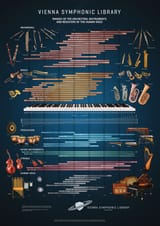Search Results
6/19/2025, 11:14:55 AM
>>126758219
>have very limited timbral variety
Why do you keep repeating this absolutely retarded, demonstrably false mantra? It's frankly absurd. The orchestral palette alone includes:
>strings (bowed, plucked, harmonic overtones, mutes, sul ponticello, sul tasto, col legno…)
>woodwinds (single reed, double reed, air jets, overblowing, multiphonics possible)
>brass (lip buzz, mutes, wide dynamics, massive overtones)
>percussion (tuned and untuned, metallic, membranophones, wood, skin, metal, even pitched percussion like vibraphone, glockenspiel, celesta, tubular bells, etc.)
>keyed instruments (piano, celesta, organ, harpsichord)
>the human voice, which is in itself massively varied
And that's not even getting into extended techniques developed in the 20th century, or the expansion into electronic instruments, tape, noise, prepared instruments, and so on.
If anything, classical music as a tradition has arguably the BROADEST timbral arsenal of any tradition in world music. Pop and rock use maybe 3-5 primary timbres in total. An electric guitar with effects pedals is timbrally interesting, but it’s not "more variety", it's just a different flavor of limited palette.
>saxophone
That was largely a political thing in the 19th century. The instrument came late historically and by then, the Romantic orchestral tradition had essentially codified its standard ensemble. Composers like Berlioz and Bizet were open to the saxophone, French military bands used it widely, Sousa's American wind bands used it heavily. The problem wasn't that classical composers "hated expressivity", it's just that orchestral institutions are conservative and evolve slowly. By the time composers like Ravel, Debussy, Prokofiev, Shostakovich, and others started writing saxophone parts, the instrument was already strongly associated with military bands, popular music, and (soon) jazz.
>saxophone is the most expressive wind instrument
That's purely subjective and just an opinion.
>have very limited timbral variety
Why do you keep repeating this absolutely retarded, demonstrably false mantra? It's frankly absurd. The orchestral palette alone includes:
>strings (bowed, plucked, harmonic overtones, mutes, sul ponticello, sul tasto, col legno…)
>woodwinds (single reed, double reed, air jets, overblowing, multiphonics possible)
>brass (lip buzz, mutes, wide dynamics, massive overtones)
>percussion (tuned and untuned, metallic, membranophones, wood, skin, metal, even pitched percussion like vibraphone, glockenspiel, celesta, tubular bells, etc.)
>keyed instruments (piano, celesta, organ, harpsichord)
>the human voice, which is in itself massively varied
And that's not even getting into extended techniques developed in the 20th century, or the expansion into electronic instruments, tape, noise, prepared instruments, and so on.
If anything, classical music as a tradition has arguably the BROADEST timbral arsenal of any tradition in world music. Pop and rock use maybe 3-5 primary timbres in total. An electric guitar with effects pedals is timbrally interesting, but it’s not "more variety", it's just a different flavor of limited palette.
>saxophone
That was largely a political thing in the 19th century. The instrument came late historically and by then, the Romantic orchestral tradition had essentially codified its standard ensemble. Composers like Berlioz and Bizet were open to the saxophone, French military bands used it widely, Sousa's American wind bands used it heavily. The problem wasn't that classical composers "hated expressivity", it's just that orchestral institutions are conservative and evolve slowly. By the time composers like Ravel, Debussy, Prokofiev, Shostakovich, and others started writing saxophone parts, the instrument was already strongly associated with military bands, popular music, and (soon) jazz.
>saxophone is the most expressive wind instrument
That's purely subjective and just an opinion.
Page 1
